If you are a coach or course creator looking for a platform to build a digital presence, Kajabi vs Wix is often put into consideration. Both platforms offer powerful tools to help you create a website and connect with your audience, but they serve different goals and have unique functions. Kajabi focuses on digital course creation with all-in-one business tools. Meanwhile, Wix is known for its flexible website builder and robust eCommerce features to sell products of all kinds.
Understanding your concern, we’ve created this detailed Kajabi vs Wix comparison to help you make an informed choice. In this article, let's break down both platforms in terms of:
- Pricing
- Online course selling
- Checkout options
- Payment gateways
- Membership creation
- Ease of use
- Website building & templates
- Marketing tools
- Support
Without further ado, let's get started!
Kajabi vs Wix – An Overview
When comparing Kajabi vs Wix, it's helpful to understand what each platform is designed to do. Both solutions enable you to build a website and expand your online presence, yet they fit different types of users with varying business objectives. While Kajabi is more focused on online course and coaching session delivery, Wix caters to more business purposes by supporting multiple product types.
In this section of our Kajabi vs Wix comparison, let's explore each platform's pros & cons to see which one fits your needs.
Kajabi pros & cons
Kajabi is a leading platform designed specifically for knowledge entrepreneurs. It combines website building, course hosting, email marketing, and payment processing into one streamlined system. Unlike traditional eCommerce solutions that support physical items, Kajabi mainly focuses on digital product delivery, tapping into the niche market of online coaches and course creators.

Since its dawn in 2010, Kajabi has been widely used by thousands of business owners, currently hosting over 108,000 websites across the globe, according to BuiltWith. This platform also receives an impressive user rating of 4.1/5 on Trustpilot and 4.4/5 on Capterra, representing the customers' trust and satisfaction with Kajabi.
For more honest thoughts and an in-depth breakdown of this platform, please check out our Kajabi review. But for now, let's take a quick look at Kajabi advantages and disadvantages before getting to the comparison between Kajabi vs Wix.
Pros | Cons |
✓ All-in-one platform for website, courses, email marketing, and funnels. ✓ No transaction fee required. ✓ Built specifically for digital products and online courses. ✓ Good built-in automation tools and analytics features. ✓ Strong customer support and training resources. | ✕ Higher starting price compared to other platforms. ✕ Limited design flexibility compared to Wix ✕ No support for physical product selling. ✕ Limited third-party app marketplace. |
Wix pros & cons
On the other hand, Wix is one of the most popular website builders on the market, hosting over 7 million users worldwide, according to BuiltWith. Known for its drag-and-drop editor and design flexibility, Wix is a favorite among small business owners, freelancers, and creatives who want to build a professional website without needing to code. On review platforms like Capterra, Wix maintains a strong user rating of around 4.4 out of 5, which reflects its ease of use and wide feature set.
We think Wix is a great choice for users who prioritize visual design, affordability, and quick setup. It’s particularly useful for those who need a stylish website fast and don’t require advanced backend functionality. For more insights about this platform, please don't hesitate to check out our Wix review article.
Below, we’ve listed the key Wix pros and cons of using this platform to help you decide if it’s the right choice for your project.
Pros | Cons |
✓ Affordable pricing plan with a free tier. ✓ Easy-to-use drag-and-drop website builder. ✓ Excellent collection of well-designed website templates. ✓ Good eCommerce features that support both physical and digital products. ✓ Good App Market for extending functionality. | ✕ Limited scalability for complex websites. ✕ Unable to switch templates once the site is live. ✕ Advanced customization options may require in-depth technical knowledge. |
Kajabi vs Wix: What Are The Differences?
As we mentioned above, Kajabi vs Wix are different at their core, providing users with distinguished tools to build their online presence. Therefore, to help you compare the two platforms clearly, here's a breakdown based on key decision-making criteria:
Criteria | Kajabi | Wix | Who wins |
Pricing | Higher starting price, ranging from $89 to $399 per month. | Affordable pricing plans, ranging from $17 to $159 per month. | Wix |
Online course selling | Built-in course builder with powerful community features like challenges, badges, and leaderboard. | Course functionality available via add-ons, but not core | Kajabi |
Payment gateways | Supports limited payment gateways with only Stripe and PayPal. | Supports 80+ payment gateways. | Wix |
Membership creation | Built-in tools for gated content and subscriptions. | Requires third-party apps or workarounds. | Kajabi |
Ease of use | Beginner-friendly with guided workflows for online businesses. | Visual editor is flexible but has a steeper learning curve. | Kajabi |
Website building & templates | Limited variety, conversion-focused templates. | 800+ templates, full design freedom. | Wix |
Marketing features | Basic functions with built-in email marketing and SEO customization. | Built-in email marketing and SEO tools. Good blogging features. | Wix |
Support | Email, Help Center, webinars. Live chat available for Pro pricing tier. | Email, Help Center, phone call. No live chat support. | Kajabi |
In short, we believe Kajabi is best for digital entrepreneurs who want everything under one roof to launch, market, and sell courses or memberships. It reduces the need for extra tools and integrations, making it easier to manage. On the other hand, Wix is the better choice for general-purpose websites, especially if you’re selling physical products or need more design control. It's also more cost-effective for beginners testing their business ideas.
As we continue on this Kajabi vs Wix review, let's talk more about the differences between both platforms. Stay tuned!
Pricing – Wix Is More Affordable
When analyzing Kajabi vs Wix in terms of pricing, we've come to a conclusion. While Kajabi offers an all-in-one platform for digital entrepreneurs, it comes at a higher monthly cost. In contrast, Wix is highly scalable and affordable, allowing users to gradually upgrade as their needs grow.
To help you get more insights, in this section, we’ll walk you through each platform’s pricing plans and break down what you get for your money. Then, we’ll share our honest opinion on which option gives you better value.
Kajabi pricing
Kajabi offers four monthly plans, each designed specifically to sell digital products, such as courses, memberships, and coaching services. Each plan includes a comprehensive suite of tools, email marketing, landing pages, automation, and course creation, allowing users to manage their entire business from a single platform.
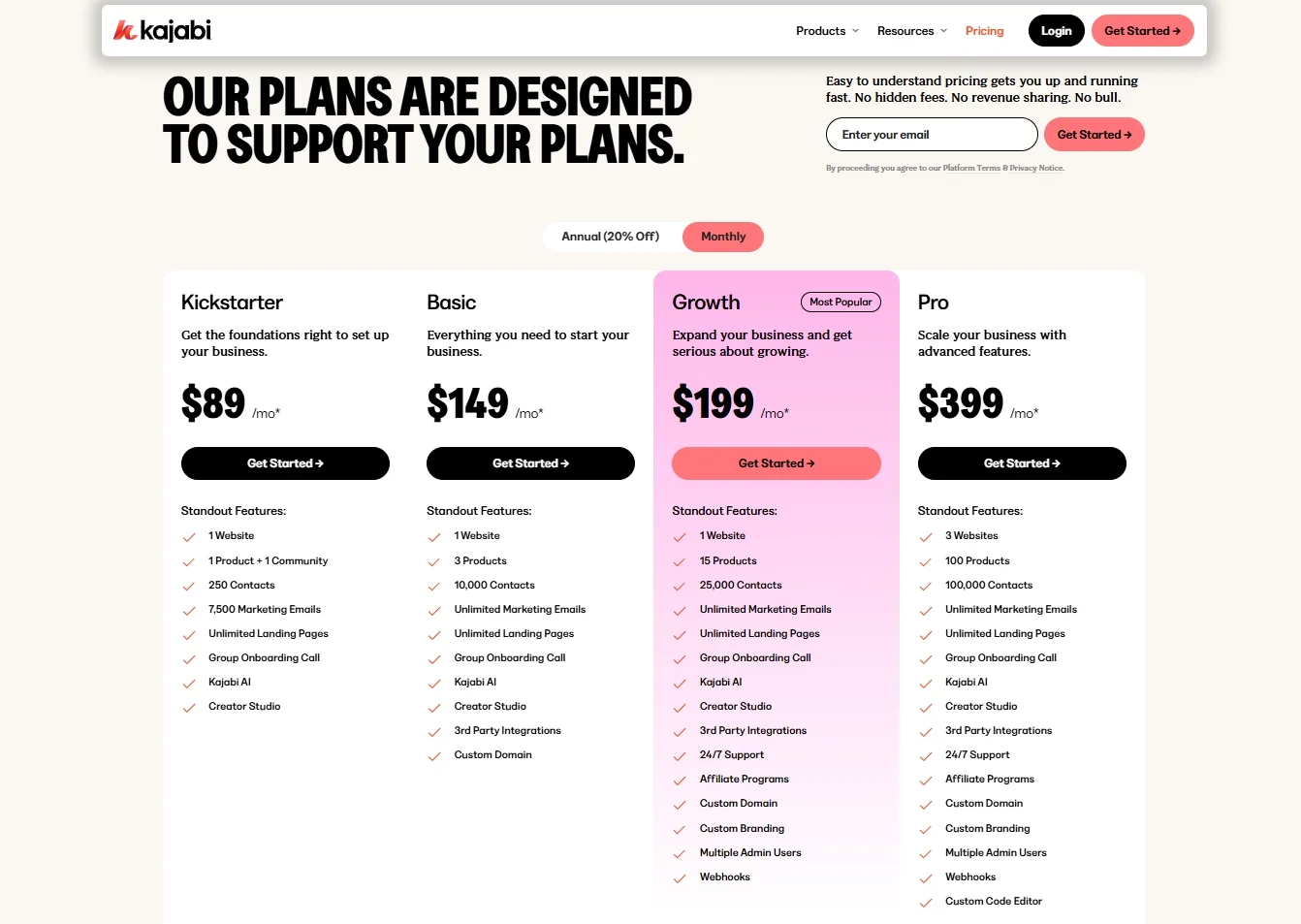
However, with a price tag ranging from $89 to $399, Kajabi is quite a premium option compared to other website builders in the market. This might be a barrier for those who are just beginning or have simpler website needs. Therefore, we think Kajabi will be better for those who plan to sell high-value digital content and want a streamlined experience without needing multiple software tools.
Wix pricing
On the other hand, Wix is known for its affordability and flexibility, making it a great choice for users who want to build a website or launch an online store without a large upfront cost. Whether you're a freelancer, small business owner, or creative professional, Wix offers a range of pricing plans that scale with your needs.
What makes Wix stand out is its low entry point. You can start with a basic Light plan for as little as $17/month and gradually upgrade to the Business Elite for $159/month as your business grows. Additionally, each plan includes hosting, a free domain for one year, and access to Wix’s drag-and-drop website builder.
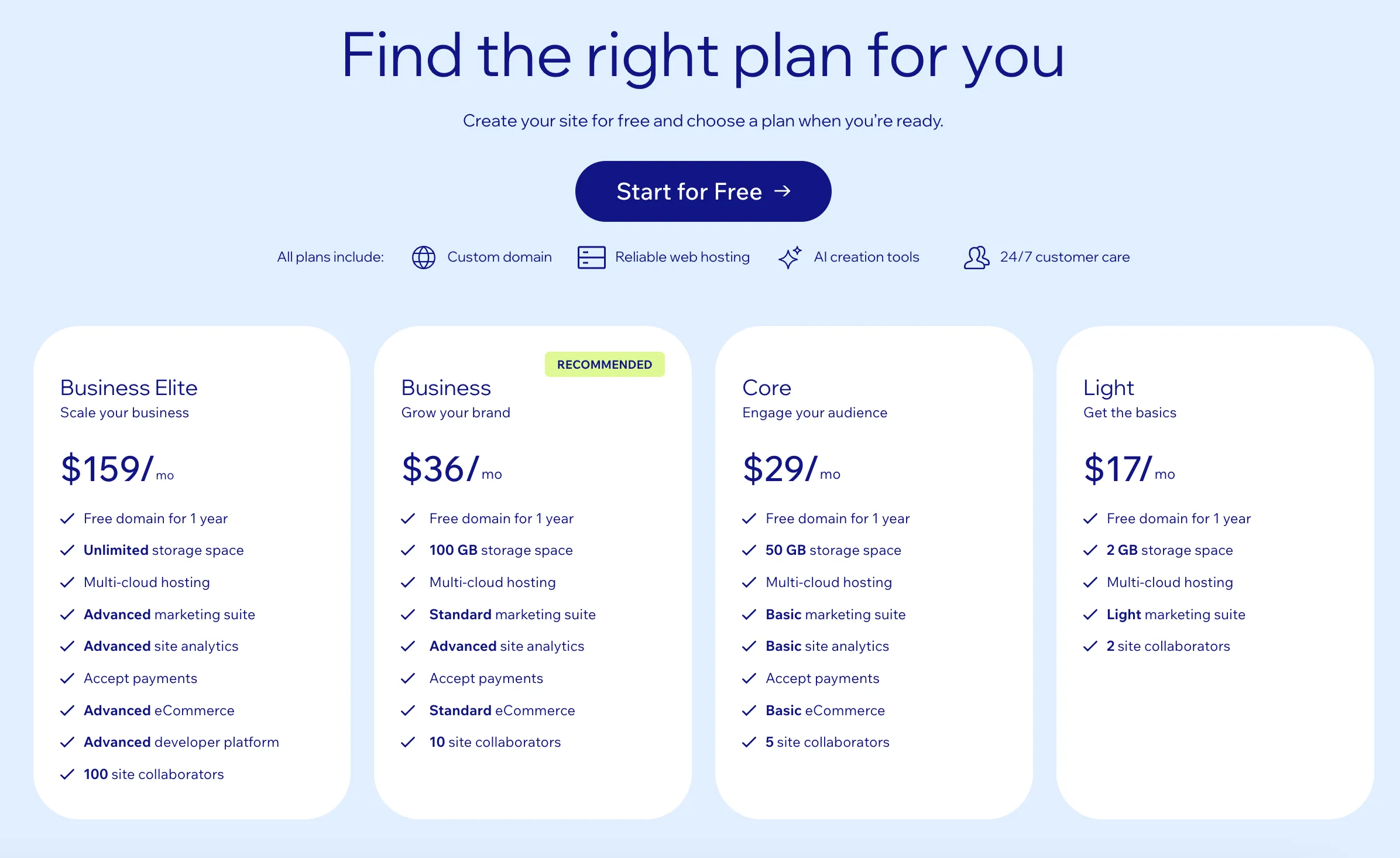
In short, we believe Wix’s pricing model is ideal for users who want to start small and scale up only when needed. With its flexible plan options and competitive pricing, Wix is especially appealing for entrepreneurs who want full control over their costs as they grow their online presence.
The verdict:
From our perspective, Wix is the clear winner between Kajabi vs Wix in terms of pricing. It’s more accessible to beginners and small teams, allowing you to expand at your own pace without incurring high upfront costs. Every dollar goes further with Wix, especially if you do not need advanced course-selling tools.
Online Course Selling – Kajabi Wins
Both Kajabi vs Wix offer some ability to deliver educational content online, but they are built with different priorities in mind.
Kajabi is specifically designed for course creators, coaches, and knowledge-based entrepreneurs. It includes all the essential tools you need to build, host, and market your courses, without relying on third-party apps. Wix, while flexible and feature-rich, focuses more on website creation and general eCommerce. Its course delivery options are more limited and often require workarounds or integrations.
Let’s break down how each platform handles course creation and sales.
Kajabi online course selling
Kajabi is built from the ground up to help creators and educators build, launch, and sell online courses with ease. Unlike traditional website builders that require extra plugins or third-party tools, Kajabi includes everything you need, right out of the box. This makes it an ideal platform for coaches, instructors, and digital entrepreneurs who want to focus on content, not code.

Here’s why Kajabi stands out in the world of online course selling:
- Structured course builder: Kajabi lets you organize your content into modules and lessons, making it easy to build structured learning experiences. You can upload videos, audio, PDFs, and text, then arrange them with a simple drag-and-drop interface.
- Student engagement tools: Each course can include progress tracking, comment sections, and challenges to enhance interaction. You can even award certificates of completion to keep students motivated.
- Flexible pricing options: Whether you want to offer one-time payments, subscriptions, or payment plans, Kajabi supports multiple pricing models, without needing to integrate a separate eCommerce tool.
- Mobile-friendly learning: Students can access your courses from anywhere using Kajabi’s mobile app, giving them a seamless experience across devices.
In short, Kajabi gives creators everything they need to grow a course-based business—from the first lesson to the final sale. If your goal is to turn your knowledge into income, Kajabi makes it easy to do just that, all in one place.
Wix online course selling
Wix is a popular choice for building websites, but when it comes to selling online courses, it offers only basic solutions, not a full learning management system (LMS) like Kajabi. If you're looking to offer a simple course experience, Wix can get the job done using built-in features and optional apps. However, for more advanced course needs, its limitations quickly become clear.
Here’s what you can expect from Wix’s course-selling capabilities:
- Course delivery through workarounds: Wix doesn’t include a native course builder. Instead, creators often use Wix Bookings or apps like Online Programs by Wix to structure and deliver lessons. These tools support video lessons, live classes, or scheduled sessions.
- Content access control: With the Wix Members Area, you can create private pages and grant access only to paid users. This allows you to set up gated course content, but it lacks the polish and structure of platforms built for learning.
- Multiple payment option available: By integrating with popular payment solutions, Wix allows you to charge customer one-time fees or recurring subscriptions with simple setup.
- Lack of progress tracking or quizzies: Unlike Kajabi, Wix doesn’t support student progress tracking, certificates, or interactive assessments. This limits the learning experience and makes it harder to manage student engagement.
To conclude, Wix is a flexible but limited option for online education. It works well for creators who want to add simple lessons or video content to a larger website, but it’s not ideal for full-scale course businesses. If you need structure, automation, and a professional student experience, a dedicated course platform like Kajabi is a better fit.
The verdict:
When it comes to selling online courses between Kajabi vs Wix, Kajabi is the clear winner. It offers a streamlined, all-in-one system built with educators in mind. Everything from course creation to delivery and sales is integrated into a single platform, without reliance on third-party software.
Ease of Use – Kajabi Wins
When it comes to ease of use between Kajabi vs WordPress, both platforms aim to simplify the website and business-building process, but they do it in different ways. Kajabi offers a streamlined, all-in-one experience designed specifically for digital entrepreneurs. Meanwhile, Wix provides powerful design tools, but with more flexibility comes more complexity.
Let’s explore how each platform performs when it comes to user experience and simplicity.
Kajabi ease of use
Kajabi stands out for its seamless, all-in-one approach that is clearly built with simplicity and user guidance at its core. From the moment you log in, Kajabi provides an onboarding experience that is both structured and welcoming, offering users a step-by-step checklist, video tutorials, and starter templates to help you set up your site, courses, email marketing, and payment system without needing to search for separate tools or learn complex software.
Besides, the dashboard is thoughtfully designed to keep everything in one place, from course creation and website editing to customer relationship management and analytics. Everything is clean, well-organized, and streamlined with minimal distraction or clutter. Hence, we believe that users never feel lost or overwhelmed as they build their digital business with Kajabi.
To top it off, Kajabi AI offers content generation support that helps you write compelling copy for landing pages, emails, and course outlines. This tool significantly reduce the amount of time it takes to go from idea to launch, making your course creation and wesite building with Kajabi easier and more convenient.
Wix ease of use
Wix, in contrast, is well-known for offering incredible design freedom, which allows users to customize every element of their website’s appearance. Its drag-and-drop editor is visually powerful and flexible, which is ideal for users who want pixel-perfect control over their site’s layout and branding.

However, with that freedom comes a steeper learning curve, especially for beginners who are unfamiliar with web design principles or overwhelmed by the platform’s many settings. You may need to spend more time tweaking designs, understanding layouts, and installing third-party apps to match the features Kajabi offers by default. Furthermore, another limitation of Wix is that once you select and publish a template, you cannot switch to a new one without rebuilding your entire website from scratch. This can be a major drawback for users who are still experimenting with their branding or want the flexibility to redesign their site over time.
The verdict:
Between Kajabi vs Wix in terms of ease of use, Kajabi takes the lead in this criterion. Its simplified layout, built-in tools, and creator-focused design make it easy for anyone to launch an online business, even without technical experience. Whether you're setting up a course, configuring payment options, or sending email campaigns, the process is guided, streamlined, and frustration-free.
Website Building & Templates – Wix Wins
When comparing Kajabi vs Wix in this area, it’s easy to see that while both platforms allow users to create professional websites, they approach design and customization very differently. Kajabi stands out for its seamless, all-in-one approach that is clearly built with simplicity and user guidance at its core. In contrast, Wix is well-known for offering incredible design freedom, which allows users to customize every element of their website’s appearance.
Therefore, in this section, let's see how Kajabi vs Wix stacks up in terms of website building and templates.
Kajabi website-building capabilities
Taking a different approach from other website builders, it's designed not for creative expression but for business efficiency, especially for those selling online courses, coaching programs, or memberships. Everything from templates to layout options is optimized for lead generation, email capture, and sales conversion.
Kajabi offers a block-based website builder, meaning you build pages by stacking pre-made content sections (e.g., hero banners, testimonials, opt-in forms, FAQs). Each block is designed with a specific marketing purpose in mind, allowing you to customize fonts, colors, images, and button styles. However, this approach might not be the best fit for those who value design freedom, since you are working within a framework.

Besides, the number of website themes Kajabi offers is smaller than Wix, but each is mobile-optimized, clean, and purpose-built. However, it's worth noting that the pricing for the Kajabi website template is quite high, ranging from $149 to $1,497 per option. This can be a huge limitation for those who are running on a tight budget.

Wix website-building capabilities
In contrast, Wix is arguably one of the most robust visual website builders available today. It’s designed for anyone who wants to build a beautiful, modern, and fully customized website without needing to touch a single line of code.
With Wix, users can start from over 800 professionally designed website templates that span every industry, from fashion, photography, and events to eCommerce, consulting, and tech startups. Every element on the page, such as text, images, buttons, videos, and contact forms, can be added, moved, resized, and styled exactly how you want. You’re not limited to a grid or block-based structure, which gives users a true WYSIWYG (What You See Is What You Get) experience.
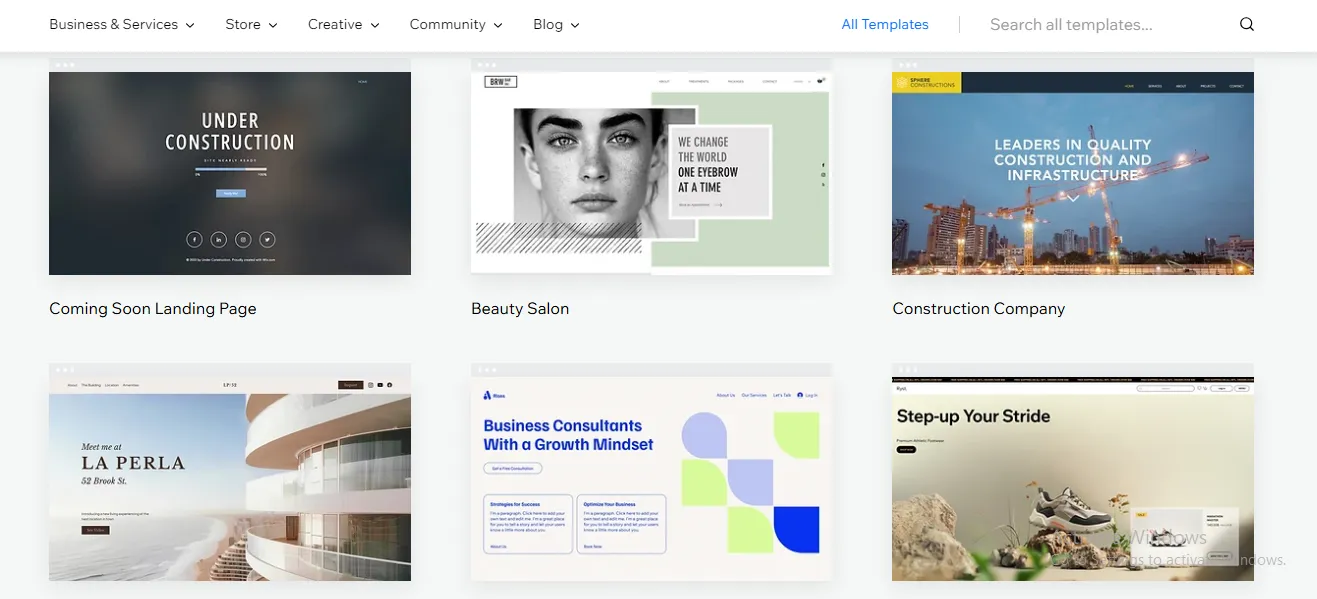
If you’re not sure where to begin, Wix also offers Wix ADI (Artificial Design Intelligence), a tool that builds an entire website for you in minutes based on your answers to a few questions. It’s a major time-saver for beginners or non-designers who want something professional without starting from scratch.
On top of that, Wix also supports advanced features like:
- Full-width video and parallax scrolling
- Animation effects for elements
- Custom mobile views with device-specific tweaks
- Developer tools (Velo by Wix) for those who want to add custom code and APIs

Nonetheless, one known limitation of Wix is that once you publish your site with a selected template, you cannot switch to another template without rebuilding your content. This restriction can be inconvenient for users who like to redesign frequently.
The verdict:
When it comes to website building and design flexibility between Kajabi vs Wix, Wix is the clear winner. Its drag-and-drop editor, expansive template library, and creative freedom make it an ideal platform for users who want their website to look exactly how they envision it.
Marketing Features – Wix Wins
In the battle of Kajabi vs Wix, marketing tools are a crucial area to evaluate, especially if your goal is to attract leads, engage your audience, and convert visitors into paying customers. Both platforms offer built-in marketing capabilities, but they cater to different types of users and business goals.
Kajabi was built for creators and educators who want a simplified, all-in-one system to launch and automate marketing campaigns without needing additional tools. On the other hand, Wix takes a broader and more versatile approach to marketing with a strong focus on SEO, email marketing, social media integration, and CRM functionality.
In this section of our Kajabi vs Wix, we'll dive deep into the marketing features that each platform offers to help you decide which best suits your needs.
Kajabi marketing features
Kajabi’s marketing features are centered around automation, lead nurturing, and funnel creation, making it ideal for users focused on selling digital products or running membership sites. Some standout features include:
- Pipeline: Kajabi offers done-for-you marketing funnels, called Pipelines, that include landing pages, opt-in forms, and email sequences. You can set them up in just a few clicks to automate your lead generation and sales processes.
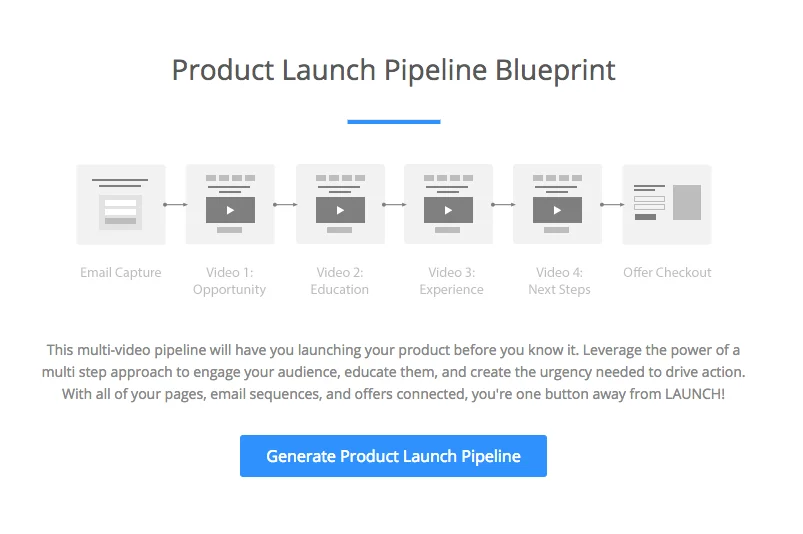
- Email marketing: Kajabi includes a full email marketing system with templates, segmentation, automation rules, and performance tracking. It allows for behavior-based email triggers, such as “send this email if someone finishes a lesson” or “didn’t complete checkout.”
- Limited SEO Tools: Kajabi provides basic SEO capabilities, like meta tags and alt text fields, but lacks more advanced control over structured data, indexing rules, and performance enhancements.
To conclude, Kajabi’s strength lies in its ability to help digital entrepreneurs automate their sales funnel and nurture leads without relying on external tools. However, for businesses that rely heavily on SEO, content marketing, or multi-channel promotions, their tools may feel somewhat limited.
Wix marketing features
Wix offers a much broader marketing toolkit that covers not just automation and email but also SEO, content distribution, and client communication. Whether you’re running a service-based business, a local store, or an online shop, Wix gives you the flexibility to promote your brand across multiple channels.
Key marketing features of Wix include:
- Wix Email Marketing: You can create and send branded emails using customizable templates. Campaigns can be automated based on site activity (e.g., cart abandonment, new subscriber welcome) and integrated with Wix’s CRM.

- SEO Tools: Wix provides an SEO Setup Checklist, customizable meta descriptions and URLs, structured data markup, redirects, and integration with Google Search Console, all built into the dashboard. These tools give you full control over how your content ranks.
- Marketing Integrations & Analytics: You can integrate Google Analytics, Facebook Pixel, and hundreds of third-party tools through Wix’s App Market. It also includes built-in tools for tracking campaign performance and visitor behavior.
In short, Wix’s marketing capabilities are more versatile and powerful, especially for users who rely on organic traffic, social engagement, and in-depth data to drive business growth.
The verdict:
In the debate of Kajabi vs Wix, when it comes to marketing, Wix is the clear winner due to the breadth and flexibility of its tools. It not only covers the basics, like email and automation, but also offers strong SEO capabilities, social media integration, and advanced analytics, all in a unified ecosystem.
Support – Wix Wins
In the matchup of Kajabi vs Wix, both platforms offer solid support options, but there are key differences in availability, accessibility, and overall user experience that make one platform stand out more than the other.
Kajabi provides strong support tailored to creators and digital entrepreneurs, focusing on quality assistance and education. However, Wix edges ahead by offering more flexible support options, faster response availability, and a larger ecosystem of self-service resources and professional services that cater to a broader range of users.
Let’s take a detailed look at how each platform handles customer support and service.
Kajabi support
To help users learn and grow, Kajabi also offers a dedicated training hub called Hero University, which includes structured courses, webinars, and tutorials designed to teach users how to maximize the platform’s features. In addition, Kajabi provides a well-organized Help Center with step-by-step guides, as well as access to a private Facebook community where users can ask questions and share advice.
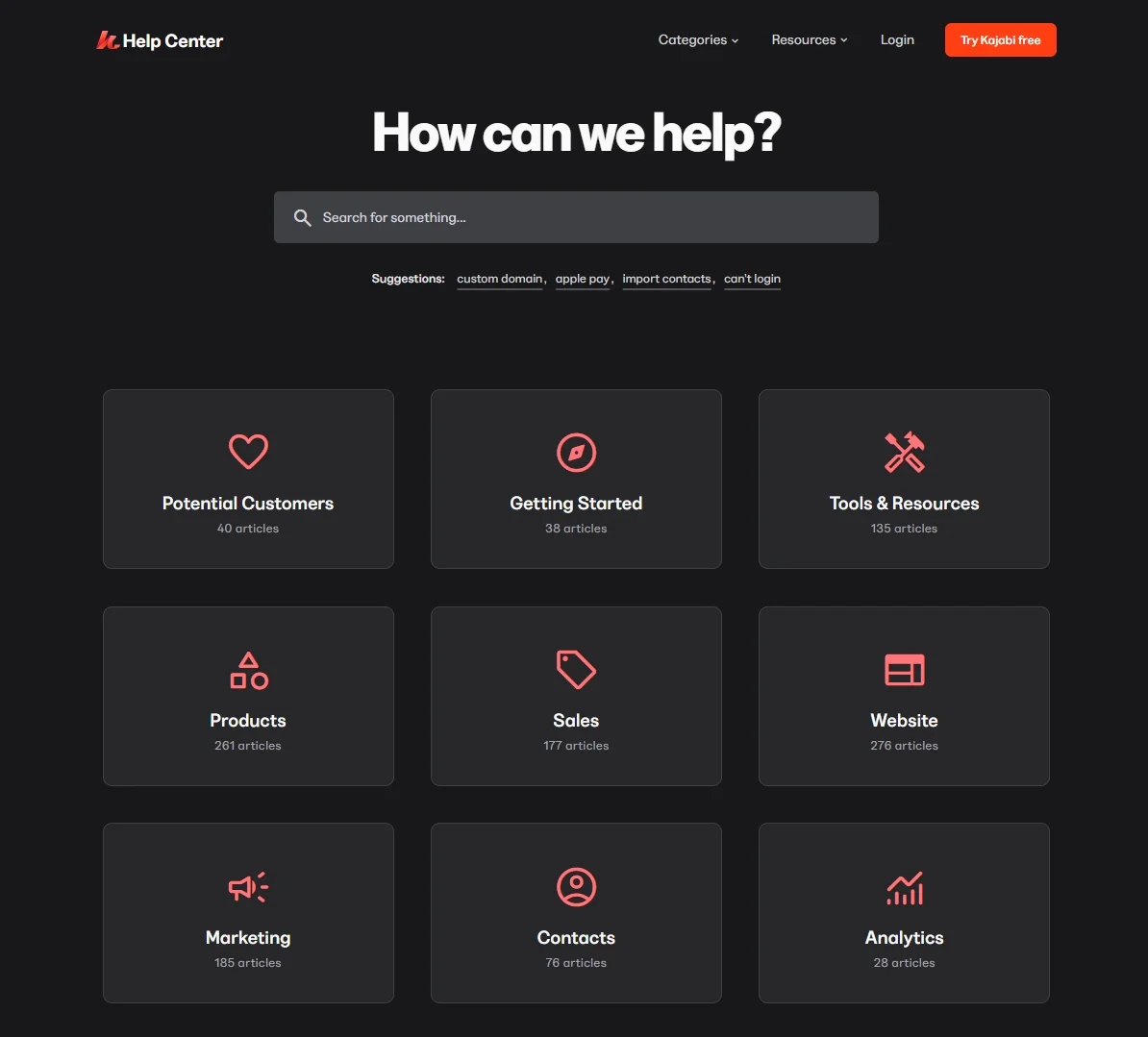
Besides, Kajabi provides a personalized support experience that aligns well with its focus on digital creators and educators. The platform offers email support for all users, while live chat is reserved for those on the Growth and Pro plans. Although the quality of support is generally praised, one key limitation is that Kajabi’s live support is not available 24/7; it operates during specific business hours, which may not be convenient for users in different time zones or those working late hours.
Wix support
In contrast, Wix offers a rich library of self-service resources, including hundreds of articles, video tutorials, and step-by-step guides found in its Help Center. The platform also integrates helpful in-editor tooltips and pop-ups, so users can get context-specific assistance as they build their site. For those who need professional design, development, or marketing support, Wix’s Partner Program connects users with certified experts who can provide tailored services on demand.

Wix delivers a more comprehensive and widely accessible support system that caters to users across all business types and time zones. One of Wix’s biggest advantages is its timely customer support, available through ticketing, live chat, and phone callbacks in multiple languages. This constant availability ensures that users can get help at any time, whether they're resolving technical issues during a product launch or working on a site after hours.
Another noteworthy advantage is Wix’s use of AI-powered chatbot assistance, which allows users to quickly resolve common questions without waiting for a live agent. Combined with its global reach and user-friendly support infrastructure, Wix makes it much easier for users to stay productive and resolve issues quickly.
The verdict:
When we look at Kajabi vs Wix in terms of customer support, Wix clearly wins thanks to its availability, larger self-service library, multilingual support, and access to certified professional services. Whether you’re launching your first website or scaling an online store, having immediate access to help can make all the difference, and Wix delivers on that promise consistently.
Kajabi vs Wix – The Bottom Line
After comparing Kajabi vs Wix across multiple categories, it's clear that both platforms serve different types of users with distinct goals. Therefore, choosing the right one depends entirely on what you plan to build and how you want to run your business.
Who should use Kajabi
We recommend Kajabi for digital creators, course sellers, coaches, and membership-based businesses who want an all-in-one solution. If your main focus is on selling digital products like online courses, coaching programs, or digital downloads, Kajabi gives you everything you need under one roof, including a course builder, email marketing, automation workflows, landing pages, and CRM.
Use Kajabi if:
- Your main income stream is from digital courses or coaching.
- You want built-in tools for marketing, automation, and payments.
- You prefer a structured, conversion-focused website layout.
- You’re willing to invest more upfront for an all-in-one experience.
Who should use Wix
We recommend Wix for small business owners, freelancers, creatives, eCommerce sellers, and anyone who values visual freedom and affordability. With a vast selection of templates, an intuitive drag-and-drop editor, strong SEO tools, and excellent customer support, Wix makes it easy to build and manage a professional site without needing to code. It’s also significantly more affordable, which makes it ideal for beginners or users testing a business idea.
Use Wix if:
- You want maximum design control and creative freedom.
- You’re building a general business website, online store, or portfolio.
- You need SEO and marketing tools that support multiple industries.
- You’re looking for a budget-friendly, flexible solution.
In short, in the Kajabi vs Wix debate, there’s no one-size-fits-all winner, just the right tool for the right user. If you're building a business around content, education, and automation, Kajabi is worth the investment. But if your focus is on creative control, broad functionality, and affordability, Wix is the platform that delivers more flexibility for your vision.
Kajabi vs Wix – FAQs
Is Wix or Kajabi better?
It depends on your business goals. Kajabi is better for digital entrepreneurs who want an all-in-one platform for selling online courses, coaching, and memberships. It comes with built-in marketing tools, automation, and a course builder. On the other hand, Wix is better for users who need flexible website design, affordability, and broader functionality for general business use, blogging, or selling physical products.
Is Wix compatible with Kajabi?
Wix and Kajabi are not directly integrated, but you can still connect them manually. For example, you could use Wix as a front-facing website and then link to your Kajabi landing pages, courses, or checkout pages. You can also embed Kajabi forms or buttons on a Wix site using custom code or external link redirection. While this setup requires a bit of workaround, it's possible to make the two platforms work together if you want to leverage the design flexibility of Wix alongside Kajabi’s course and funnel tools.
Can I transfer my Wix website to Kajabi?
There’s no built-in or automatic migration tool to directly transfer a Wix website to Kajabi, because the two platforms are built on very different systems. However, you can manually move your content, such as text, images, and blog posts, by recreating your pages using Kajabi’s page builder.
If you want a faster, safer, and more professional solution, we recommend using LitExtension, a trusted website migration service. LitExtension specializes in helping businesses transfer their website content securely and efficiently from one platform to another.
Who is Kajabi best for?
Kajabi is best for online course creators, coaches, consultants, and digital entrepreneurs who want a complete business platform without relying on third-party tools. It’s especially ideal for those selling digital products, hosting memberships, or running webinars. If your business revolves around your knowledge or expertise, Kajabi is a powerful, time-saving solution.
Final Words
At the end of the day, both Kajabi and Wix are excellent platforms, but the right choice depends on what you plan to build. We hope this detailed comparison has helped you understand the differences clearly so you can choose the platform that fits your vision best.

